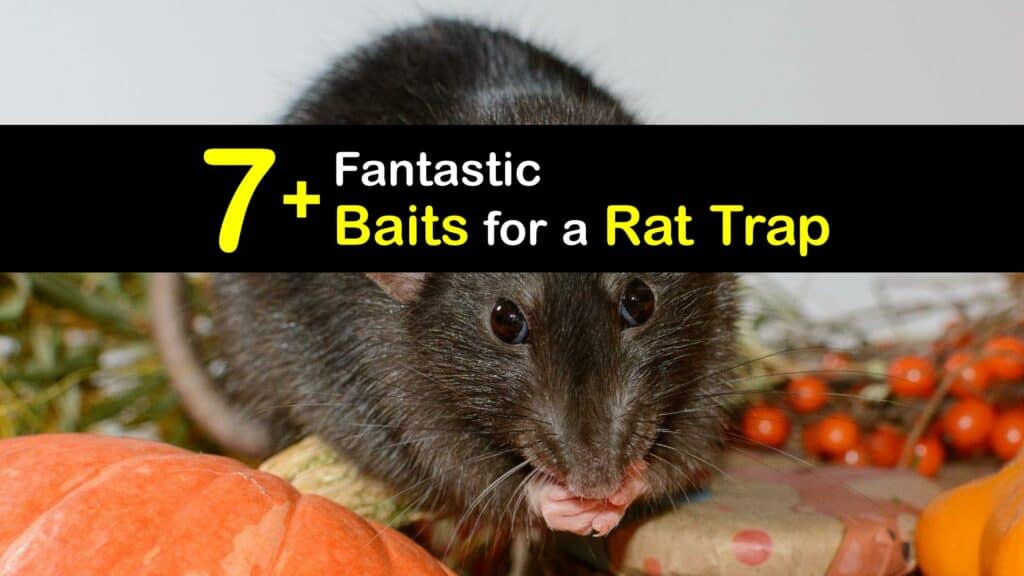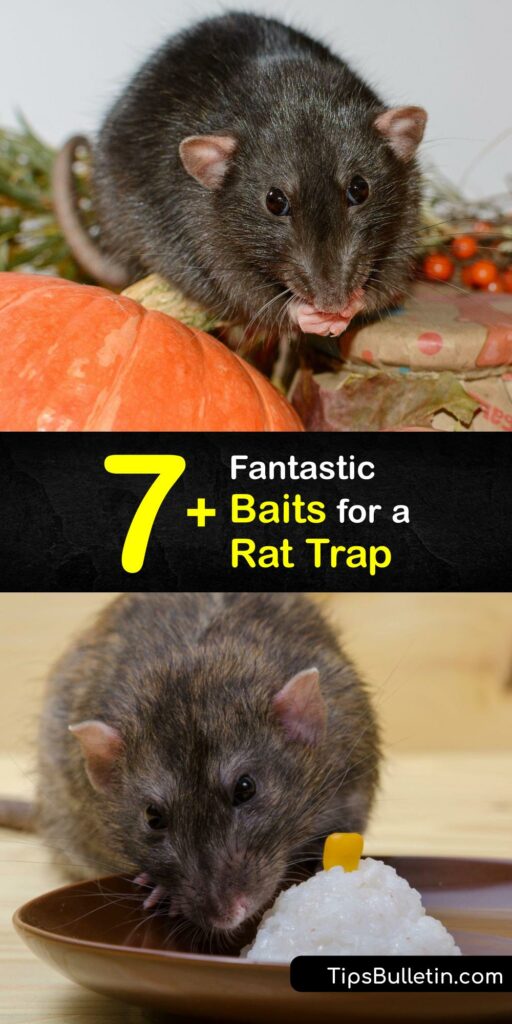It pays to know the different types of rat trap bait. Rodents are a catastrophe for a building’s structural integrity, the security of valuables, and your well-being. Rapid action is required to control the rat population and save personal possessions. Many people’s worst nightmare is finding a rat colony beneath their roof.
Nothing is more discouraging than trying to perform rat control only to have the rats fail to interact with your traps. Rats are timid critters and don’t enjoy change. It’s crucial to use the best foods for rat traps or the creatures evade the newly placed traps.
Avoid taking a chance by exposing your family to a poison bait station. Use easy methods and make your own bait for the best ways to get rid of rats in the house fast. Learn about the best bait for a rat trap and use pantry products like peanut butter, nuts, and canned meat to entice rodents into your traps.

The Best Foods for Rat Traps
Setting out an appropriate rat trap bait is key to resolving your rat problem. If you find rat droppings or spot a live rat, it’s time to procure fresh bait and lay your traps. Discover the best bait for a rat trap, and make certain you draw in plenty of rats to remove them.
The Importance of Knowing What to Put in a Rat Trap
Whether you’re trapping rats in a live trap or a commercial one, pest control success relies on selecting the right food bait. Bait is used as a lure to catch a rat’s attention and direct them into a trap or to interact with a poison.
The bait placed in a trap is a significant component of its success. A rodent ignores a trap with ineffective bait, and the rat infestation grows. Find the perfect type of bait for catching rats in the garage with homemade traps and pre-packed products to help end your rat problem.
Choose Bait to Catch Rats Based on Species
Varying species consume various kinds of food. For instance, brown rats are natural omnivores, and black rats are plant-eating animals. Depending on the type of rat you’re trying to catch, rat traps may require different types of bait.

Black rats find peanut butter appealing, and they ascend trees and enter houses through coin-sized openings in attics. Brown rats, who usually dig through trash and slither into homes through microscopic cracks, may be enticed by pungent cheese.
If you’re not sure if you’re dealing with a plant eater or an omnivore, the ideal foods to lure rats into traps are those with strong odors, like nuts, fish, or rotten cheese. These highly-scented foods work with any rat, making them an ideal starting point.
Innovative Remedies for Trapping Rats
Putting your trap in the right location is just as important as choosing a delectable bait. Walls and fences serve as natural landmarks for rats. They are less prone to wander into the middle of a space or yard.
A rat or mouse trap is typically most practical if positioned close to a wall and in dimly lit areas. Rat traps are effective when placed along routes where rats are most likely to go or in spots with high rat activity.
Place traps inside wardrobes, and below furniture, such as couches, chairs, or even cupboards, positioned along the walls to maximize your chances of catching the rodents. You can also use mothballs to keep rats away from your clothing in the closet or dressers.
Cutting holes in a shoebox and putting it along a path where rats may congregate with a loaded trap inside is a creative approach to entice them into traps. The rat is curious about what’s inside the box; they won’t come out once they get in.
Use Peanut Butter for Rat Traps
Peanut butter is an excellent choice for bait stations or rodent traps. Any nut butter is a suitable bait for rodent control as they’re universally enjoyed by everything from ship to roof rats.
Nut butter is creamy and sweet. Rodents love nut butter for its taste and easily detect it thanks to its potent scent. In addition to its popularity with rats, peanut butter is a fantastic bait choice as it’s safe.
The consequences are disastrous if your child or pet dog accidentally finds poison rat bait and eats it. Conversely, it’s inconsequential if anything but the intended target consumes peanut butter.
The Best Bait for a Rat Trap is Homemade
While many commercial rodent bait products treat your rodent infestation, it’s frugal and saves time to make your own. Pre-packaged baits are loaded with toxic substances and harmful chemicals that pose a risk to the user, children, pets, and wildlife.
Poison baits accidentally kill through ingestion but also secondary poisoning. If your dog eats a poisoned rat, they, too, become poisoned. Sidestep these upsetting consequences by using safe food bait.
Mix rat poison with bait to ensure the rat eats it. A straightforward technique to make an effective homemade rat poison is to use boric acid. Hardware stores sell this reasonably priced pesticide, which works swiftly to eliminate rats.
Combining one part boric acid with two parts peanut or almond butter makes a simple bait block. Thoroughly mix the boric acid powder and peanut butter before making several tiny balls. Place the rat bait in regions where rodent activity is prevalent. Rats discover and consume the boric acid bait.
Store-Bought Rat Trap Bait
Whether you’re using a rat glue trap or a Tomcat Press N Set Mouse Trap, your chosen bait is still crucial. There are chances rats may accidentally engage with glue traps, yet a rat bait station or snap trap relies on the food lure to draw in the rat. If you don’t feel comfortable creating rat bait, buy it.
Hardware stores offer a range of food attractants, from poison baits to scented blocks to use with snap traps. If you don’t have food bait available at home, pick up bait from the store. Read the usage guidelines carefully. Some items are incredibly harmful to children and pets. Use homemade bait where possible to subvert these risks.
Troubleshooting When Bait Doesn’t Work
If you’ve selected an appropriate bait or tried a couple of foods, and nothing seems to appeal to the rats, you’re likely dealing with food competition. Eliminate competing food sources before setting up rat traps for success.
Removing available food is a critical response after a rat trap is ineffective. Rats, in particular, are skeptical creatures who dislike trying new things and prefer to avoid engaging unless forced.
Keeping food supplies in steel containers with tight lids is a straightforward way to prevent food competition. Rats are intelligent, so make sure the covers are firmly anchored. You can also temporarily remove all food from the area. Stop adding food scraps to compost piles until trapping results reveal that rats are being captured.
When your traps don’t work, clean underneath bird feeders and take them out. Keep trash in containers with lids that are either locked or weighted with bricks or other large stones. Don’t leave tasty crumbs or scraps behind; if you do, pests will pass by your traps with little interest. Pick up all other sources of sustenance to ensure rats go to the bait.
Tips to Prevent Rats Returning
No matter how perfectly you bait and how successful your traps are, without environmental changes, the rodents return. Your home characteristics invited the rats in the first place, whether you have an accessible entry point or an abundance of food. Take simple steps to make your house less appealing to ensure the success of a rat or mousetrap.
Maintaining a clean home and making it difficult for rats to enter helps avoid an infestation starting and deters them from coming back after treatment.
Explore the best foods for rat traps to increase the odds of fruitful pest control. Rats are naturally shy, cautious creatures that won’t interact with a trap without a sufficient reason.
Discover food baits to use in your traps to eradicate the rats. Make your own baits using simple items like peanut butter, nuts, and meat. Skip expensive and dangerous pre-packaged baits.

If you loved this comprehensive article on rat trap bait, please share these insights on the best bait for a rat trap with your friends and family on Pinterest and Facebook.